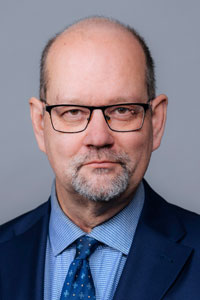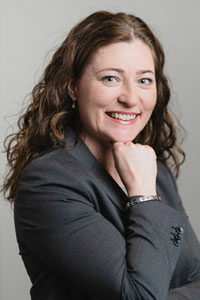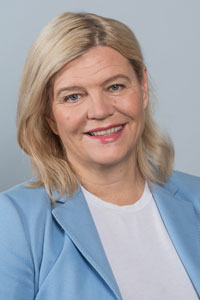Administration
Keva is an independent body governed by public law and its operations are based on the Public Sector Pensions Act and the Keva Act. Further provisions supplementing the Act can be found in the Council’s Standing Orders.
Council
The highest decision-making body in Keva is the Council.
The Ministry of Finance appoints Keva’s Councillors for each municipal and regional election term.
Keva has 30 Councillors, six of whom, by law, are appointed from among the candidates put forward by the most representative national negotiating organisations representing the personnel of municipalities and wellbeing services counties. Four are appointed from among candidates put forward by Local and County Government Employers KT.
The remaining twenty are appointed from among the candidates jointly put forward by the central organisation of municipalities and the wellbeing services counties, in such a way that municipalities, joint municipal authorities, wellbeing services counties, and different parts of the country are fairly represented by the Councillors. The share of votes received by the various groups in municipal elections and wellbeing services county elections in accordance with the principle of proportionality provided for in the Elections Act (714/1998) is taken into account in the appointment of municipal, joint municipal authority, wellbeing services county and joint county authority for wellbeing services Councillors and deputies.
The term of the current Councillors began on 1 September 2025.
The chairman of the Council is Heikki Vestman and the vice-chairman is Eero Reijonen.
Members of Council
| Regular members | Personal deputies |
| Maija Kuusisto-Länsineva, sd. | Minna Lax, sd. |
| Mikkel Näkkäläjärvi, sd. | Ilkka Nokelainen, sd. |
| Faysal Abdi, sd. | Seppo Eskelinen, sd. |
| Piritta Rantanen, sd. | Anni Lahtinen, sd. |
| Eveliina Heinäluoma, sd. | Mahad Ahmed, sd. |
| Jarmo Husso, kok. | Tiina Gallén, kok. |
| Aulikki Sihvonen, kok. | Juha Vanhanen, kok. |
| Susanna Koski, kok. | Mervi Rings, kok. |
| Heikki Vestman, kok. | Teuvo Uusimäki, kok. |
| Timo Leppäaho, kok. | Katja Isomöttönen, kok. |
| Eero Reijonen, kesk. | Erkki Kemppainen, kesk. |
| Jouni Kemppi, kesk. | Hanna Kosonen, kesk. |
| Satu Lankinen, kesk. | Tuomas Vanhanen, kesk. |
| Mervi Mäenpää, kesk. | Piia Rautiola, kesk. |
| Paula Himanen, vihr. | |
| Jussi Junni, vihr. | Anita Huhtala, vihr. |
| Silvia Modig, vas. | Eija Rannanpää, vas. |
| Miikka Kortelainen, vas. | Harri Pikkarainen, vas. |
| Päivi Karppi, ps. | Hannu Korhonen, ps. |
| Malin Brännkärr, r. | Henrik Wickström, r |
| Nina Brask, Kymenlaakson hyvinvointialue | Irma Hirsjärvi, Jyväskylä |
| Juha Rostedt Lahti | Marko Koskinen, Kitee |
| Maria Kaisa Aula, Keski-Suomen hyvinvointialue | Laura Skaffari, Lohja |
| Jarkko Virtanen, Turku | Juha Jääskeläinen, Pohjois-Pohjanmaan hyvinvointialue |
| Jonna Voima, Jyty | Jukka Maarianvaara, Jyty |
| Juha Juntunen, JHL | Anne Ranta, JHL |
| Tuomas Hyytinen, Talentia | Anna Zibellini, Suomen Lääkäriliitto |
| Petri Lindroos, OAJ | Jari Järvi, KTK Tekniikan Asiantuntijat |
| Millariikka Rytkönen, Tehy | Paula Sihto, Tehy |
| Päivi Inberg, SuPer | Jaana Dalén, SuPer |
Board of Directors
The Board’s task is the general supervision and guidance of Keva’s activities. The Board’s function, according to law, is to decide on the pension fund investment plan.
Members of Board 2025-2027
|
Regular members |
Personal deputies |
|
Toni Eklund |
Nea Karenius |
|
Daniel Sazonov |
Samu Vahteristo |
|
Diana Bergroth-Lampinen |
Harri Jokiranta |
|
Anne Holmlund |
Milla Bruneau |
|
Heli Järvinen |
Jaakko Stenhäll |
|
Markus Lohi |
Marjut Frantsi-Lankia |
|
Henrika Nybondas-Kangas |
Mika Juutinen |
|
Ari Korhonen |
Outi Mäkelä |
|
Katarina Murto |
Janne Aaltonen |
|
Keijo Karhumaa |
Kristian Karrasch |
|
Anne Sainila-Vaarno |
Millariikka Rytkönen |
Members of Management group
Personal E-mail addresses: firstname.lastname[at]keva.fi. Please, replace Scandinavian å, ä or ö. with a and o.
 Jaakko Kiander Jaakko KianderCEO |
 Kimmo Mikander Kimmo MikanderDeputy CEO |
 Maaria Kettunen CIO |
||
 Piia Laaksonen CFO and Chief Actuary |
 Reija Hyvärinen Communication Director |
 Mika Gylén, HR Director |
||
 Mikko Kenni, Director of Customer Relations and Work Ability |
|
 Staff member representative, Satu Ruuskanen Customer Manager |
||
Working Life Development Working Group
The function of the Working Life Development Working Group is to develop measures for maintaining the health and work capacity of municipal employees. The focus of the group is the improvement of the quality of working life, maintaining and improving work capacity as well as on measures preventing incapacity to work.
The working group and its function are defined in Keva’s Standing Orders. The Board appoints the working group for its term of office. Of the 12 working group members, six are chosen based on proposals by the municipal sector’s employee organisations.
Members of Working Life Development Working Group
- Chairman Arja Aroheinä
- Anne Ranta
- Jonas Fyrqvist
- Jarkko Pehkonen
- Riitta Saarikoski
- Ulla Walli
- Konstantin Laakkonen
- Anne Mikkola
- Sinikka Valtonen
- Minna Salli
- Ulla Westermarck
- Päivi Lanttola
- Mari Antikainen
- Mikko Kenni
- Merja Paananen
- Tuula Metsä
Supervision
Keva’s operations are overseen by the Financial Supervisory Authority.
Internal control, risk management and internal audit
Internal control
Internal control means all of the procedures, systems and methods through which Keva’s management and council aim to ensure efficient, economical and reliable operations and the accomplishment of its goals.
Internal control is a process which ensures the following: achieving set goals and aims as well as the economical and efficient use of resources the reliability and accuracy of financial and other management information complying with laws, regulations and instructions, as well as with decisions by administrative bodies, internal plans and operating methods.
Risk management
Risk management is an integral part of Keva’s internal control and it means the recognition, assessment, restriction and supervision of risks resulting from operations or significantly connected to them. Risk management also involves contingency and emergency planning to ensure the smooth continuation of operations.
The main objective of risk management is to support the development of Keva's operations and processes and the attainment of goals, in order to secure the rights of the insured and pension recipients in all situations.
The most significant risks for Keva are related to financing and investment activities and operational risks.
Further information on risk management: Annual report and interim reports
Internal audit
The internal audit of Keva assesses the efficiency and adequacy of internal control at the institution and provides proposals for improving operations. The internal audit operations are based on an internal audit activities plan approved annually by the Board. The function reports to the CEO and the council.
Compliance function at Keva
The Compliance function’s core duty is to assist in proactively anticipating the effects of legislative and regulatory changes on Keva’s operations. The Compliance function also serves to ensure that the entire organisation has the capacity to comply with legislation, statutory regulations and Keva’s in-house rules.
The Compliance function is tasked with the following:
- proactive anticipation of effects in legislative and regulatory changes
- promotion of compliance with acts, decrees and statutory regulations
- supervision, advice and guidance for compliance with Keva’s in-house regulations, guidelines and principles
- contribution to risk management and good governance projects within Keva
The maintenance and development of Keva’s independent Compliance function is the responsibility of the Compliance Officer whose primary function is to support the Board, management and the business in ensuring reliable administration and the effectiveness and sufficiency of internal control. Compliance reports to the CEO and also provides regular reports to the Board.
The responsibility for legislative and regulatory compliance always resides with the business units and management which are supported in this undertaking by the Compliance function.
